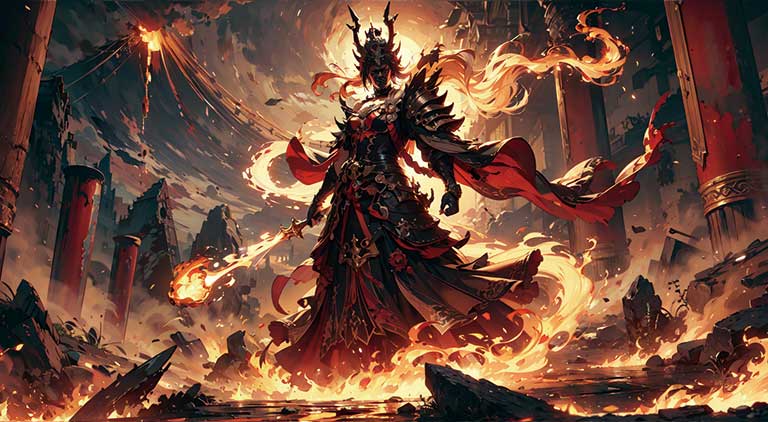In the rich tapestry of Japanese mythology, few deities embody the duality of destruction and creation as profoundly as Kagu-tsuchi, the fearsome fire god. Known as the deity whose birth brought both life and death, Kagu-tsuchi symbolizes the immense power of fire—capable of incinerating forests and forging tools essential for civilization. This article delves into the fascinating tale of Kagu-tsuchi, his tragic origin, and the many gods born from his demise, offering insight into one of the most compelling figures in Japanese mythological lore.
🔥 The Japanese Fire God: Kagu-tsuchi (迦具土)
Kagu-tsuchi (迦具土神), also known as Hinokagutsuchi (火之迦具土神 – Fire Incarnate Deity), is a prominent figure in Japanese mythology as the god of fire. His name can also be read as Homusubi (火産霊神), meaning “fire spirit” or “fire soul.” He appears in ancient texts such as the Kojiki and Nihon Shoki as the child of the divine couple Izanagi (伊邪那岐) and Izanami (伊邪那美).
🔥 Birth and Tragic Origin
Kagu-tsuchi’s birth is marked by both creation and tragedy. When he was born, his fiery nature severely burned his mother, Izanami, ultimately causing her death. This event represents the first occurrence of death in Japanese mythology and symbolizes the dual nature of fire—destructive yet essential for life.
⚔️ Izanagi’s Wrath and Kagu-tsuchi’s Death
Overcome with grief and rage, Izanagi unsheathed his legendary sword, the Ame-no-Ohabari (天之尾羽張 – Heavenly Tail Feather Sword), and decapitated Kagu-tsuchi. Yet, from the god’s spilled blood and dismembered body, numerous deities emerged, illustrating the mythological cycle of death and rebirth.
🔴 Gods Born from Kagu-tsuchi’s Blood
Kagu-tsuchi’s divine blood, flowing along different parts of the Ame-no-Ohabari sword, fell upon rocks and gave rise to several deities.
1. From the Sword’s Tip
- Iwasaku-no-Kami (石折神 – Stone-Splitting God): Symbolizing the power to fracture stone.
- Nesaku-no-Kami (根折神 – Root-Splitting God): Representing the severing of roots.
- Iwatsutsuno-no-Kami (石筒之男神 – Stone-Piercing God): Guardian of rock and stone.
2. From the Sword’s Base
- Mikahayahi-no-Kami (甕速日神 – Swift Jar God)
- Hihayahi-no-Kami (樋速日神 – Swift Flame God)
- Takemikazuchi-no-Kami (建御雷之男神 – Thunder God)
- Also known as Takefutsu-no-Kami (建布都神) and Toyofutsu-no-Kami (豊布都神).
3. From the Sword’s Hilt
- Kuraokami-no-Kami (闇淤加美神 – Dark Rain God): A deity associated with rain.
- Kuramitsuha-no-Kami (闇御津羽神 – Dark Water God): A deity connected to water.
⚰️ Gods Born from Kagu-tsuchi’s Body
From Kagu-tsuchi’s dismembered body emerged the eight Yamasumi deities, each associated with different aspects of the mountains and natural world.
- Masaka-Yamatsumi-no-Kami (正鹿山津見神 – True Deer Mountain God): From the head.
- Odo-Yamatsumi-no-Kami (淤縢山津見神 – Surging Mountain God): From the chest.
- Oku-Yamatsumi-no-Kami (奥山津見神 – Inner Mountain God): From the abdomen.
- Kura-Yamatsumi-no-Kami (闇山津見神 – Dark Mountain God): From the reproductive organs.
- Shigi-Yamatsumi-no-Kami (志藝山津見神 – Stalwart Mountain God): From the left hand.
- Haya-Yamatsumi-no-Kami (羽山津見神 – Swift Mountain God): From the right hand.
- Hara-Yamatsumi-no-Kami (原山津見神 – Field Mountain God): From the left foot.
- To-Yamatsumi-no-Kami (戸山津見神 – Gate Mountain God): From the right foot.
These deities are seen as protectors of mountains, forests, and natural landscapes throughout Japan.
🔥 Symbolism and Cultural Significance
🔸 Fire as Destruction and Creation
Kagu-tsuchi embodies the duality of fire: while it can cause devastation, it also sustains life by providing warmth, light, and energy for cooking and crafting. His myth teaches the delicate balance required to harness fire’s power.
🔸 Cycle of Death and Rebirth
The story of Kagu-tsuchi illustrates the cycle of life, death, and rebirth. From his death sprang new deities, mountains, and natural phenomena, reinforcing the belief in life’s continuity beyond destruction.
🔸 Protection from Fire
In Japan, Kagu-tsuchi is sometimes invoked as a protective deity against fire-related disasters.
🔹 Notable Shrine:
- Akiha Shrine (秋葉神社 – Shizuoka Prefecture): Known for its fire prevention rituals and veneration of fire-related deities.
🌌 Mythological Insights
Kagu-tsuchi’s tale is a profound reminder of nature’s power and the necessity of respecting elemental forces. His narrative serves as a cultural metaphor for the transformative nature of fire, which, despite its potential for destruction, fosters growth and new beginnings.


Comments